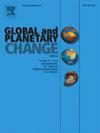西赤道太平洋第四纪铁施肥动态的洞察:巴布亚新几内亚北部近海的代理档案
IF 4
1区 地球科学
Q1 GEOGRAPHY, PHYSICAL
引用次数: 0
摘要
赤道太平洋是揭示地球气候系统动态的关键海洋学区域,在这里,营养物质的可用性(如铁、氮和磷)在控制生物泵和海洋-空气碳交换方面起着至关重要的作用,至少是部分作用。尽管如此,来源、路线和沉积过程,以及第四纪期间赤道西太平洋营养供应的施肥效应,以及巴布亚新几内亚可能作为主要铁贡献者的作用,仍然难以捉摸。本文综合分析了自275kyr以来,巴布亚新几内亚北部沿海大陆坡的岛屿侵蚀和风化、陆源物质供应、表层海洋生产力、生物物质向下输出和底水氧化还原等方面的代用档案,所有这些都与铁肥料的轨道变化密切相关。我们的研究结果表明,在这些综合记录中存在一个突出的岁差周期,与1月至3月5°S日照的变化一致。观测到的时间耦合表明,巴布亚新几内亚北部降水和侵蚀的增加刺激了养分输入,从而增加了赤道西太平洋1 - 3月5°S高日照期间的表层海洋施肥、生物生产和颗粒碳埋藏。这导致该地区在La Niña-like条件下成为一个重要的大气二氧化碳汇。我们提出,巴布亚新几内亚北部的侵蚀加剧导致赤道西太平洋的铁施肥增加。正如模式模拟预测的那样,正在进行的铁施肥可能会通过加强与未来连续La Niña事件发生率增加相关的大气二氧化碳封存来显著缓解人为的全球变暖。本文章由计算机程序翻译,如有差异,请以英文原文为准。
Insights into Quaternary iron fertilization dynamics in the western equatorial Pacific: Proxy archives offshore of northern Papua New Guinea
The equatorial Pacific is a key oceanographic region for unraveling Earth's climate system dynamics, where nutrient availability (e.g., iron, nitrogen, and phosphorus) plays a crucial role, at least partially, in governing the biologic pump and sea-air carbon exchange. Despite this, provenance, routing, and depositional processes, together with fertilization effects of nutrient supply to the western equatorial Pacific during the Quaternary, with Papua New Guinea potentially acting as a major iron contributor, remain elusive. Here, we present a comprehensive analysis of proxy archives for island erosion and weathering, terrestrial matter supply, surface ocean productivity, downward export of biogenic material, and bottom-water redox, all closely linked to orbital variations of iron fertilization, along the continental slope offshore of northern Papua New Guinea since 275 kyr. Our findings reveal a prominent precession cycle across these integrated records, aligning with changes in January–March insolation at 5°S. The observed temporal coupling indicates that heightened precipitation and erosion in northern Papua New Guinea stimulated nutrient input, thereby enhancing surface ocean fertilization, biologic production, and particulate carbon burial in the western equatorial Pacific during periods of high January–March insolation at 5°S. This caused the area to be a significant atmospheric CO2 sink during La Niña-like conditions. We propose that enhanced erosion in northern Papua New Guinea led to increased iron fertilization in the western equatorial Pacific. Ongoing iron fertilization may significantly mitigate anthropogenic global warming by enhancing atmospheric CO2 sequestration associated with increased occurrences of future consecutive La Niña events, as predicted by model simulations.
求助全文
通过发布文献求助,成功后即可免费获取论文全文。
去求助
来源期刊

Global and Planetary Change
地学天文-地球科学综合
CiteScore
7.40
自引率
10.30%
发文量
226
审稿时长
63 days
期刊介绍:
The objective of the journal Global and Planetary Change is to provide a multi-disciplinary overview of the processes taking place in the Earth System and involved in planetary change over time. The journal focuses on records of the past and current state of the earth system, and future scenarios , and their link to global environmental change. Regional or process-oriented studies are welcome if they discuss global implications. Topics include, but are not limited to, changes in the dynamics and composition of the atmosphere, oceans and cryosphere, as well as climate change, sea level variation, observations/modelling of Earth processes from deep to (near-)surface and their coupling, global ecology, biogeography and the resilience/thresholds in ecosystems.
Key criteria for the consideration of manuscripts are (a) the relevance for the global scientific community and/or (b) the wider implications for global scale problems, preferably combined with (c) having a significance beyond a single discipline. A clear focus on key processes associated with planetary scale change is strongly encouraged.
Manuscripts can be submitted as either research contributions or as a review article. Every effort should be made towards the presentation of research outcomes in an understandable way for a broad readership.
 求助内容:
求助内容: 应助结果提醒方式:
应助结果提醒方式:


